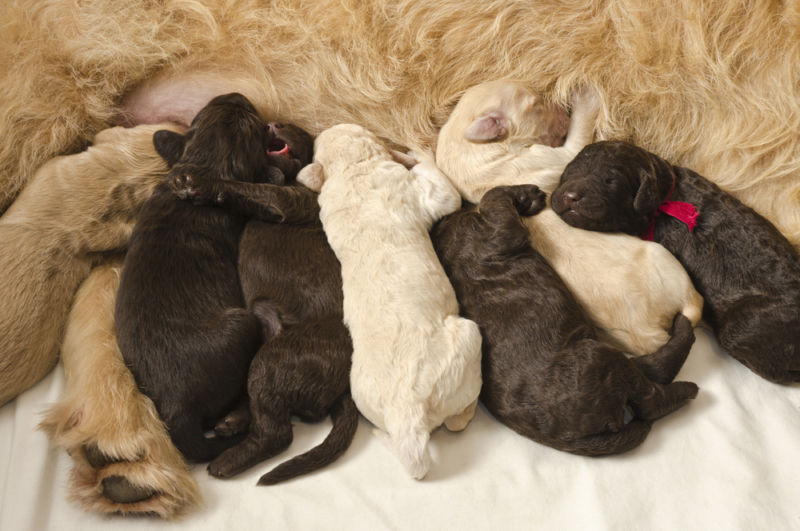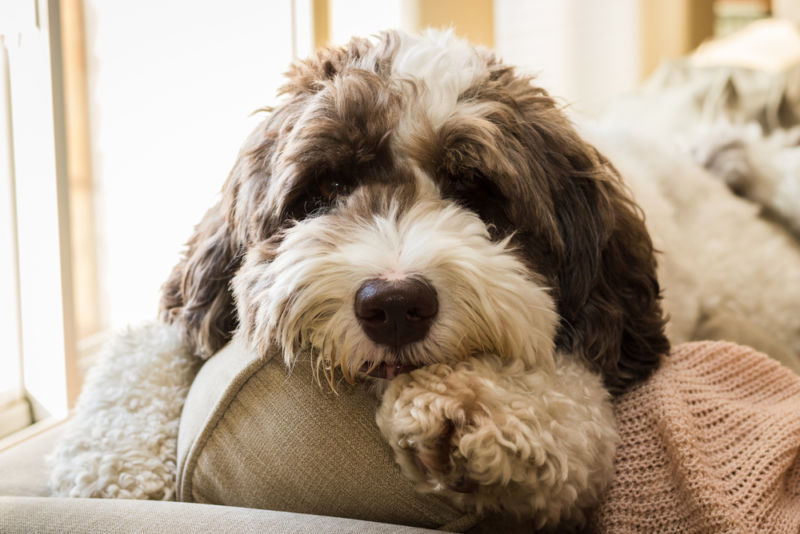If you’re interested in adopting a labradoodle puppy, you’re making a smart choice. From their friendly, playful personalities to their intelligent, eager-to-please natures, there are plenty of advantages to owning labradoodles.
While pretty much any labradoodle will keep you happy and entertained, there are a few steps you can take on how to pick a labradoodle puppy from a litter and to ensure you’re picking the right puppy for your needs. Let’s go over what makes these precious puppies special and what to look for when choosing a labradoodle puppy.

What Are Labradoodle Puppies?
While labradoodles can be found in many households today, there was a time when they didn’t even exist. In fact, the breed didn’t arise until the late 1980s, when Wally Conron (an employee at the Royal Guide Dogs Association of Australia) decided to merge the genetic material of Labrador retrievers and poodles.
Conron’s goal was to create a hypoallergenic guide dog to help blind people with allergies. Not only was this new breed low-shedding and hypoallergenic, but it was also incredibly friendly and intelligent. It’s no wonder that the unique breed quickly grew in popularity.
Why Should I Adopt a Labradoodle Puppy?
With so many unique dog breeds out there, you might be wondering, “Why should I adopt a labradoodle puppy?” Here are some of the great personality traits that make labradoodles stand out:
- Friendliness: From young kids and older adults to strangers and other dogs, labradoodles can get along with just about anyone. Their sociable, affectionate natures make labradoodle puppies great for new owners and experienced pet parents alike.
- Playfulness: If you’re looking for a puppy that will accompany you on runs or play games of fetch, a labradoodle fits the bill. Most labradoodles require around 30 to 60 minutes of exercise a day, which can be easily fulfilled by walks or games.
- Intelligence: Thanks to their poodle parentage, labradoodle puppies are highly intelligent. Their natural curiosity and eagerness to please makes them fairly easy to train (which is why labradoodles are common candidates for therapy dogs).
While labradoodle puppies tend to have many traits in common, it’s important to remember that every puppy is unique. That’s why it’s important to know what you’re looking for in a new puppy before making an official choice.
What Should I Look for When Choosing a Labradoodle Puppy?
When choosing a labradoodle puppy, there’s a good chance you’ll select your desired dog from a litter. Most mother dogs give birth to anywhere from one to 12 puppies at a time, with the average being just a few pups (around five to six).
If you’re wondering how to pick a labradoodle puppy from a litter, you’re not alone. It can be hard to single one puppy out — each one is adorable! Here are a few important factors you should look out for.
Size
Every new pet owner wants to go home with a healthy puppy. One of the best ways to make sure you’re picking a puppy that’s in good condition is by paying careful attention to its size. Sometimes, size doesn’t mean anything; however, in many cases, it can be indicative of health or behavioral problems.
When picking a puppy out of a litter, try to go with one that’s around medium or average-sized. If a puppy is much smaller than its littermates, it may have a congenital or genetic issue that could affect its lifespan. On the flip side, if a puppy is the largest of the litter, it may be stealing food, which could mean it has trouble listening to commands.
Personality
The way a labradoodle puppy acts around its siblings and mother dog can be very indicative of its personality. When examining a litter, watch how the puppies interact with one another. A withdrawn, shy pup that keeps to itself may have aggression and biting issues in the future. An aggressive, independent pup that bullies other dogs may be reluctant to listen to commands. Meanwhile, a friendly, relaxed pup that gets along with its littermates will likely be easy to train.
Of course, a puppy’s personality changes as the dog gets older and undergoes training. Just because a puppy misbehaves doesn’t mean it’ll always act badly — many adult dogs grow out of their poor habits. However, if you take the time to choose a puppy that exhibits positive, outgoing traits, you’ll have a better training experience.
Playfulness
The way a labradoodle puppy acts around its littermates can tell you a lot about its personality. But what about the way it acts around you? Not only can a puppy’s interactions with humans give you insight into its personality, they can also tell you how easy (or difficult) it may be to train.
As you greet the puppies, observe how they behave. The puppies that rush forward and are interested in playing are more likely to be sociable and friendly. See if any puppies roll over on their backs — pets that exhibit this behavior tend to be more easygoing and trusting, which will come in handy while training.
Gender
For many prospective owners, the gender of their new puppy is probably inconsequential. After being spayed or neutered, gender rarely influences a pup’s personality (which means you should not expect many differences between male and female labradoodle puppies). However, if you already have a dog at home, gender may be an important factor to consider.
According to many experts, male and female canines tend to get along better than two dogs of the same sex. Thus, if you have a female dog at home, you should consider getting a male pup (and vice versa). While this isn’t a hard-and-fast rule, pairing opposite-sex puppies (that have been spayed and neutered) can reduce the risk of aggression and competition.
Appearance
Many prospective dog owners have a certain look in mind when searching for a new pet. For example, some people may want a puppy with a solid-colored coat, while others like multicolored pups. If you have any appearance preferences, look for a puppy that meets those expectations.
Generally, you can expect labradoodle siblings to look pretty similar. However, there may be some slight differences — for example, one may have a traditional, golden curly coat, while another has a few spots of white. The only thing you can count on for sure is that all the labradoodles will share a distinguishable curly coat.
Health
A labradoodle puppy’s external appearance offers more than cosmetics — it can also help you determine whether it has any health issues. To make sure you’re going home with a healthy pup, look out for the following:
- Coat: Your new puppy should have a shiny coat with no redness or bald spots.
- Legs: Is your desired puppy walking and running normally? Any limping indicates a paw or leg injury.
- Head: The top of a pup’s head will likely have a soft spot. If this spot is larger than the size of a dime, the puppy may experience bone problems in the future.
- Gums: Ideally, a puppy’s gums should be pink and moist, and the teeth should align properly.
- Stomach: Check to see if there are any protrusions or hernias around the belly area.
- Eyes & ears: The eyes and ears should not have any drainage or discharge. Moreover, the puppy should not be scratching its eyes and ears excessively.
While monitoring a puppy’s appearance can help reduce the risk of health problems, the best way to ensure your new pet is in top-notch shape is by working with a reputable breeder, such as Pride & Prejudoodles.

Questions To Ask When Choosing a Labradoodle Puppy
There’s no doubt you can obtain a ton of information just by observing how a labradoodle puppy acts around its peers. However, the truth is you can’t know everything about a puppy after a couple of hours of observation. That’s why it’s important to rely on the people who’ve been around the puppies since they were born: the breeders.
Reputable breeders should answer your questions thoroughly and do everything they can to help you find your perfect match. Here are some good questions to ask.
How Does the Puppy Behave in General?
No puppy acts the same way throughout the entire day. Let’s say you’re looking for an active, sociable labradoodle puppy — you’re probably going to ignore the one that’s taking a nap during your visit. However, in reality, that puppy could be the most energetic of the litter, and it could be napping because it’s tired from running around all day.
If you’re interested in a certain puppy, ask the breeder how it behaves in general. You should also mention any specific personality traits you’re looking for. The breeder will let you know if the puppy is a good match or if another puppy might be better for you.
What Does the Puppy Like To Do?
Before you take any puppies home, try to get some more specific information about them. For example, you could ask what activities a puppy enjoys. If you exercise frequently and want a labradoodle puppy that can keep up with your excursions, the breeder can direct you to an active puppy. On the flip side, if you prefer to stay in, the breeder can introduce you to a calmer, lower-energy puppy.
Asking what a puppy’s interests can also give you deeper insight into how easy it’ll be to train. For instance, if the breeder says a puppy likes spending time with people and learning new tricks, it suggests that the puppy will be more responsive to training.
What Do the Parents Look Like?
Generally, standard labradoodle puppies grow to be anywhere from 20 to 25 inches in height. You can get a better idea of what your new labradoodle puppy is going to look like by observing the parents. For example, if the parents seem too large, you might want to try another litter.
In some cases, you may be able to meet the parents of your new labradoodle puppy in person. Of course, this isn’t always an option — if the parents aren’t available, ask your breeder what they looked like or if there are any pictures.
Are the Puppies Health-Tested?
Provided they’re raised properly and taken care of, labradoodles can live up to 14 years. Of course, there’s always the risk of health problems. Labradoodles are susceptible to the following issues:
- Ear infections
- Skin allergies
- Progressive retinal atrophy
- Hip and elbow dysplasia
As mentioned earlier, you can learn a lot about a labradoodle puppy’s health just by looking at it. For example, ear discharge could indicate an infection, while a dull coat suggests skin allergies. However, observations can’t measure up to a thorough health testing. Make sure the breeder health-tests all their labradoodles for common puppy diseases.
Get a Labradoodle Today!
You’ve probably heard the phrase “the pick of the litter.” Some people truly believe there’s one puppy that will outshine its siblings. The truth is, there’s no such thing as one perfect puppy. There are probably plenty of healthy, friendly puppies within a litter that would fit well in your home. The best way to find the right puppy is by observing the litter, asking the right questions and working with a high-quality breeder.
At Pride & Prejudoodles, we do everything we can to help families find the perfect puppies for their homes. All our trained labradoodle puppies go through health and coat testing, as well as obedience training and housebreaking that meets therapy dog standards. No matter which labradoodle you end up with, you can rest assured it’s well-trained, respectful and in prime condition. Learn more by contacting us today!
